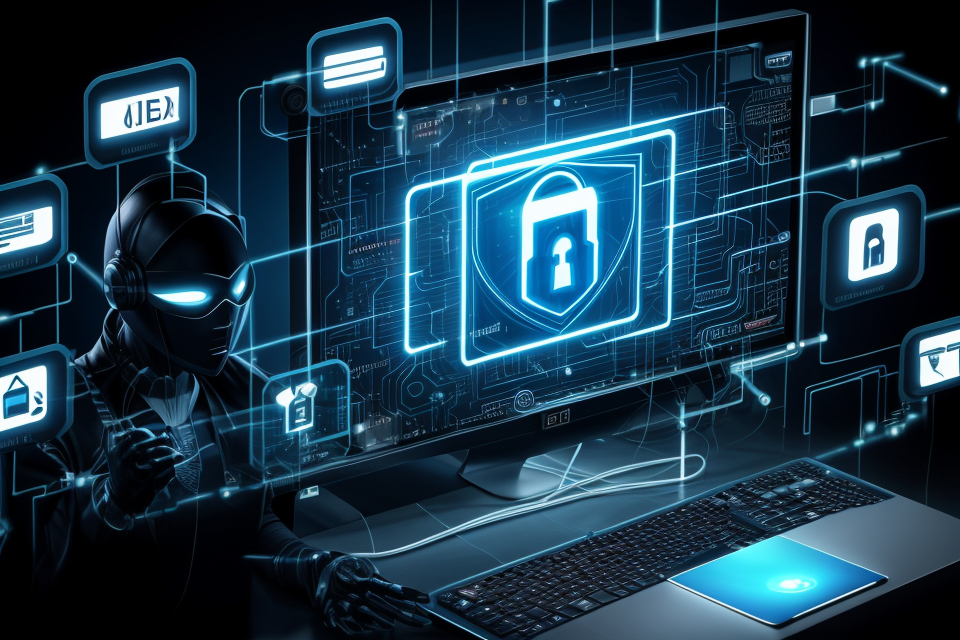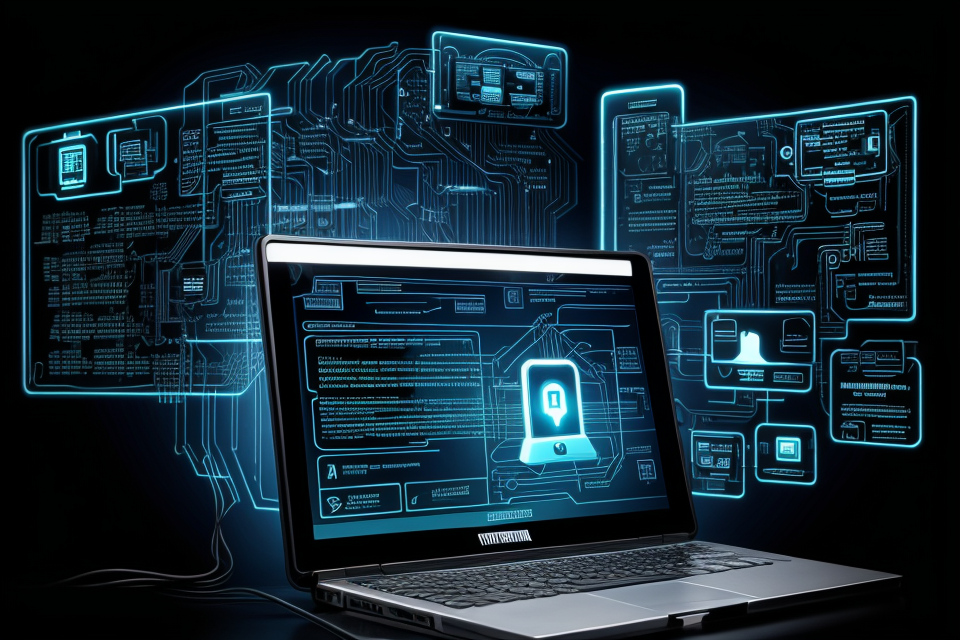In today’s interconnected world, the internet plays a vital role in our daily lives. From online banking to social media, our personal and professional lives are heavily dependent on the internet. However, with the increasing number of cyber-attacks, it has become essential to understand the importance of cybersecurity. Cybersecurity is the practice of protecting computers, servers, mobile devices, electronic systems, networks, and data from digital attacks, theft, and damage. This comprehensive guide will provide an in-depth understanding of the role of cybersecurity in protecting our digital world.
The Basics of Cybersecurity
Understanding the importance of cybersecurity
- Cybersecurity is a critical aspect of protecting our digital world from cyber threats.
- It is essential to understand the importance of cybersecurity in today’s interconnected world.
The growing threat of cyber attacks
- Cyber attacks are becoming increasingly common and sophisticated.
- Hackers and cybercriminals are constantly developing new methods to breach security systems and gain access to sensitive information.
- These attacks can result in financial loss, identity theft, and reputational damage.
The value of sensitive information
- Sensitive information, such as personal data and financial information, is stored and transmitted electronically.
- This information is valuable to hackers and cybercriminals who can use it for financial gain or other malicious purposes.
- Protecting this information is critical to ensuring the security and privacy of individuals and organizations.
The key components of cybersecurity
Cybersecurity is a comprehensive field that encompasses various aspects of protecting digital assets, networks, and systems from unauthorized access, theft, damage, or attack. In this section, we will discuss the key components of cybersecurity, which serve as the foundation for a robust and effective cybersecurity strategy.
Network security
Network security refers to the measures taken to protect the confidentiality, integrity, and availability of data transmitted over a network. This includes the use of firewalls, intrusion detection and prevention systems, virtual private networks (VPNs), and other security protocols to secure data transmission and prevent unauthorized access to network resources.
Endpoint security
Endpoint security focuses on securing the devices that access and interact with a network, such as computers, laptops, smartphones, and tablets. This involves the implementation of antivirus software, firewalls, and other security measures to protect these devices from malware, viruses, and other cyber threats.
Application security
Application security refers to the measures taken to ensure that software applications are secure and free from vulnerabilities that could be exploited by cybercriminals. This includes the use of secure coding practices, vulnerability scanning, and penetration testing to identify and remediate security weaknesses in software applications.
Cloud security
Cloud security involves the protection of data and applications stored in cloud computing environments. This includes the use of encryption, access controls, and other security measures to ensure that sensitive data is protected in the cloud and that cloud-based applications are secure from cyber threats.
Identity and access management
Identity and access management (IAM) refers to the processes and technologies used to manage and secure user identities and access to digital resources. This includes the use of strong authentication mechanisms, such as two-factor authentication, as well as access controls and auditing to ensure that only authorized users have access to sensitive data and systems.
In summary, the key components of cybersecurity are network security, endpoint security, application security, cloud security, and identity and access management. Each of these components plays a critical role in protecting digital assets, networks, and systems from cyber threats, and a comprehensive cybersecurity strategy should incorporate all of these components to ensure the highest level of security.
The Role of Cybersecurity in Protecting Our Digital World
Securing critical infrastructure
In today’s interconnected world, critical infrastructure is increasingly reliant on digital systems. This makes it vulnerable to cyber attacks that could cause significant damage to our society. Cybersecurity plays a crucial role in protecting these critical systems, ensuring that they remain secure and reliable.
Power grids
Power grids are a critical component of our modern society, providing electricity to homes, businesses, and industries. A cyber attack on a power grid could result in widespread blackouts, disrupting the lives of millions of people. Cybersecurity measures are in place to prevent such attacks, including network segmentation, access controls, and monitoring for anomalous activity.
Water treatment plants
Water treatment plants are responsible for providing clean drinking water to communities. A cyber attack on these systems could result in contaminated water being distributed, posing a significant risk to public health. Cybersecurity measures are implemented to protect these systems, including network segmentation, access controls, and regular software updates.
Transportation systems
Transportation systems are essential for the movement of people and goods. A cyber attack on these systems could result in disruption to traffic flow, causing significant delays and potentially even accidents. Cybersecurity measures are implemented to protect transportation systems, including network segmentation, access controls, and regular software updates. Additionally, transportation systems may use technologies such as GPS tracking and remote monitoring to detect and respond to potential cyber threats.
Protecting sensitive government data
In today’s digital age, sensitive government data is vulnerable to cyber attacks, making it essential for cybersecurity to play a critical role in protecting it. Cybersecurity helps governments to safeguard their classified information and personal data of citizens from unauthorized access, theft, and misuse. In this section, we will delve into the details of how cybersecurity protects sensitive government data.
Classified information
Governments handle a vast amount of classified information, including national security secrets, defense strategies, and intelligence operations. Cybersecurity plays a vital role in safeguarding this sensitive information from cyber attacks, data breaches, and unauthorized access. This includes the use of encryption technologies, firewalls, and intrusion detection systems to prevent unauthorized access and ensure that only authorized personnel can access the information. Additionally, cybersecurity professionals are trained to identify and respond to potential threats, including phishing attacks, malware, and ransomware, which can compromise classified information.
Personal data of citizens
Governments also hold personal data of citizens, including financial information, health records, and criminal history. This data is highly sensitive and needs to be protected from unauthorized access and misuse. Cybersecurity measures such as data encryption, access controls, and secure data storage help to protect personal data from cyber attacks and data breaches. Governments also have legal and regulatory frameworks in place to ensure that personal data is collected, stored, and used in accordance with privacy laws and regulations.
Furthermore, cybersecurity professionals are trained to identify and respond to potential threats, including identity theft, phishing attacks, and social engineering. They work to ensure that the personal data of citizens is protected from cyber attacks and misuse, and that their privacy is respected.
In conclusion, cybersecurity plays a critical role in protecting sensitive government data, including classified information and personal data of citizens. By implementing strong cybersecurity measures, governments can safeguard their sensitive data from cyber attacks and protect the privacy of their citizens.
Safeguarding financial systems
Banking and finance
- Financial institutions store and process sensitive information such as personal identification, financial records, and transaction details. Cybersecurity plays a critical role in safeguarding this information from unauthorized access, theft, or loss.
- Cybersecurity measures employed in banking and finance include firewalls, intrusion detection systems, antivirus software, encryption, and secure socket layer (SSL) protocols. These technologies help prevent cyber attacks such as malware infections, phishing scams, and data breaches.
- Banks and financial institutions also have policies and procedures in place to ensure that their employees follow best practices for cybersecurity. This includes guidelines for password management, email and internet usage, and physical security measures.
E-commerce
- E-commerce platforms process a large volume of financial transactions daily, making them a prime target for cyber attacks. Cybersecurity is crucial in protecting both the customers and the businesses involved in these transactions.
- E-commerce companies implement various cybersecurity measures such as SSL encryption, tokenization, and fraud detection algorithms to secure online transactions.
- In addition, e-commerce platforms have measures in place to protect against Distributed Denial of Service (DDoS) attacks, which can disrupt website availability and cause financial losses.
- Companies also invest in employee training and awareness programs to educate their staff on the latest cyber threats and best practices for protecting sensitive information.
In summary, cybersecurity plays a vital role in safeguarding financial systems by protecting sensitive information, preventing cyber attacks, and ensuring the availability and integrity of financial transactions.
Ensuring the security of our digital communications
Email is one of the most widely used methods of communication in the digital world. It is also one of the most vulnerable to cyber attacks. Cybersecurity measures are put in place to protect the confidentiality, integrity, and availability of email communications. This includes the use of encryption to protect the content of emails, as well as the use of digital signatures to ensure the authenticity of the sender. Additionally, email servers are often protected by firewalls and intrusion detection systems to prevent unauthorized access and malicious activity.
Instant messaging
Instant messaging is another popular method of digital communication that is vulnerable to cyber attacks. Cybersecurity measures are implemented to protect the privacy and security of instant messaging conversations. This includes the use of end-to-end encryption to protect the content of messages, as well as the use of authentication methods to ensure that only authorized users can access the conversation. Additionally, instant messaging servers may be protected by firewalls and intrusion detection systems to prevent unauthorized access and malicious activity.
Video conferencing
Video conferencing has become increasingly popular in recent years, especially with the rise of remote work and virtual meetings. Cybersecurity measures are put in place to protect the privacy and security of video conferencing sessions. This includes the use of encryption to protect the content of the video conference, as well as the use of authentication methods to ensure that only authorized users can access the session. Additionally, video conferencing servers may be protected by firewalls and intrusion detection systems to prevent unauthorized access and malicious activity. It is also important to ensure that the video conferencing software being used is up to date and has the latest security patches installed to prevent any known vulnerabilities from being exploited.
Cybersecurity and the future of technology
The Internet of Things (IoT)
The Internet of Things (IoT) refers to the interconnection of physical devices, vehicles, buildings, and other objects, which are embedded with sensors, software, and network connectivity, allowing them to collect and exchange data. The proliferation of IoT devices has brought numerous benefits, such as improved efficiency, enhanced convenience, and increased automation. However, it has also introduced new cybersecurity challenges. As these devices often lack robust security measures, they can be vulnerable to hacking, data breaches, and other cyber threats. Therefore, cybersecurity plays a critical role in protecting IoT devices and ensuring their secure operation.
Artificial Intelligence (AI)
Artificial Intelligence (AI) is transforming various aspects of our lives, from healthcare to transportation. AI systems can process vast amounts of data, learn from experience, and make intelligent decisions. However, as AI systems become more autonomous and integrated into critical infrastructure, they also become more vulnerable to cyber attacks. Hackers can exploit AI systems’ weaknesses, manipulate their decision-making processes, and cause significant damage. Therefore, cybersecurity must be integrated into the design, development, and deployment of AI systems to protect against these threats.
Quantum computing
Quantum computing is an emerging technology that has the potential to revolutionize computing by solving problems that are currently impractical or impossible for classical computers to solve. However, quantum computing also poses significant cybersecurity challenges. Quantum computers can crack many of the encryption algorithms that are currently used to secure online transactions, communications, and data storage. Therefore, cybersecurity researchers are working to develop new encryption methods that are resistant to quantum attacks. Additionally, cybersecurity professionals must be trained in quantum computing principles and techniques to defend against these threats.
Cybersecurity Challenges and Solutions
The human factor in cybersecurity
Employee education and training
- Providing employees with regular training on cybersecurity best practices
- Educating employees on how to identify and respond to potential threats
- Encouraging a culture of security awareness within the organization
Implementing security policies and procedures
- Developing and implementing security policies and procedures that are tailored to the organization’s specific needs
- Ensuring that all employees are aware of these policies and procedures and understand their role in implementing them
- Regularly reviewing and updating these policies and procedures to ensure they remain effective
Conducting regular security audits
- Conducting regular security audits to identify potential vulnerabilities and weaknesses in the organization’s systems and networks
- Using the results of these audits to make improvements and implement additional security measures as needed
- Ensuring that all employees are aware of the importance of these audits and are prepared to cooperate with them
In conclusion, the human factor plays a crucial role in cybersecurity. By providing employees with the knowledge and resources they need to identify and respond to potential threats, implementing security policies and procedures, and conducting regular security audits, organizations can help protect themselves against cyber attacks and ensure the security of their digital assets.
Keeping up with the latest cyber threats
In today’s interconnected world, cybersecurity threats are becoming increasingly sophisticated and pervasive. It is crucial for organizations and individuals to stay ahead of these threats to protect their digital assets and sensitive information. This section will explore the challenges of keeping up with the latest cyber threats and the solutions that can help mitigate them.
Threat intelligence
Threat intelligence is a critical component of cybersecurity. It involves collecting, analyzing, and disseminating information about potential cyber threats. Threat intelligence can help organizations identify and prioritize their security efforts by providing them with a better understanding of the types of threats they face and the attackers behind them.
One way to gather threat intelligence is through the use of security information and event management (SIEM) systems. These systems collect and analyze data from various sources, such as network traffic, server logs, and security devices, to identify potential threats. Another way to gather threat intelligence is through the use of threat intelligence platforms, which aggregate data from multiple sources to provide a comprehensive view of the threat landscape.
Security software and hardware
In addition to threat intelligence, organizations can also use security software and hardware to protect against cyber threats. Firewalls, intrusion detection and prevention systems, and antivirus software are all examples of security tools that can help protect against known threats.
However, it is important to note that security software and hardware are not foolproof. Cybercriminals are constantly developing new ways to bypass security measures, and some attacks can be so sophisticated that they are able to evade detection altogether. Therefore, it is essential to use a combination of security tools and strategies to protect against a wide range of threats.
Penetration testing
Another way to keep up with the latest cyber threats is through penetration testing. Penetration testing, also known as pen testing or ethical hacking, involves simulating an attack on a system or network to identify vulnerabilities and weaknesses. By conducting regular penetration tests, organizations can identify potential weaknesses in their security defenses and take steps to mitigate them before they can be exploited by attackers.
Penetration testing can be performed internally by an organization’s IT team or by external vendors. It is important to ensure that any penetration testing is conducted in a safe and controlled manner to avoid causing any unintended damage to the system or network being tested.
In conclusion, keeping up with the latest cyber threats is a critical challenge for organizations and individuals alike. By leveraging threat intelligence, security software and hardware, and penetration testing, it is possible to stay ahead of the ever-evolving threat landscape and protect against a wide range of cyber threats.
The future of cybersecurity
As the digital landscape continues to evolve, so too must the field of cybersecurity. The future of cybersecurity is marked by emerging technologies, the need for global cooperation, and the critical role of ethics in this field.
Emerging technologies and their impact on cybersecurity
The rapid pace of technological advancement has led to the development of new technologies that are changing the way we live and work. From the Internet of Things (IoT) to artificial intelligence (AI), these technologies bring with them new challenges and opportunities for cybersecurity professionals.
IoT devices, in particular, pose a significant threat to cybersecurity due to their lack of built-in security measures. As more and more devices are connected to the internet, the attack surface for cybercriminals grows larger, making it increasingly difficult to protect against cyber attacks.
The need for global cooperation in cybersecurity
As cyber threats become more sophisticated and widespread, the need for global cooperation in cybersecurity becomes increasingly important. Cybercrime knows no borders, and coordinated efforts between nations are necessary to effectively combat cyber threats on a global scale.
One example of this is the Budapest Convention on Cybercrime, which provides a framework for international cooperation in investigating and prosecuting cybercrime. However, there is still much work to be done in terms of developing international standards for cybersecurity and ensuring that all nations are working together to protect against cyber threats.
The role of ethics in cybersecurity
As cybersecurity professionals, it is essential to consider the ethical implications of our work. This includes issues such as privacy, surveillance, and the use of cyber weapons. Ethical considerations must be taken into account when developing and implementing cybersecurity measures to ensure that they are effective and responsible.
In addition, cybersecurity professionals must be aware of the potential for abuse of their skills and knowledge. It is important to maintain ethical standards and to be mindful of the impact of our work on individuals and society as a whole.
Overall, the future of cybersecurity is marked by the need for ongoing innovation and collaboration. As the digital landscape continues to evolve, cybersecurity professionals must stay ahead of emerging threats and work together to protect our increasingly interconnected world.
FAQs
1. What is cyber security?
Cybersecurity is the practice of protecting computer systems, networks, and data from unauthorized access, theft, damage, or attack. It involves implementing measures to prevent, detect, and respond to cyber threats and attacks.
2. Why is cyber security important?
Cybersecurity is important because our daily lives are increasingly dependent on technology and the internet. From banking and shopping to communication and entertainment, the digital world has become an integral part of our lives. Cybersecurity helps protect our personal and sensitive information, as well as critical infrastructure and systems, from cyber threats and attacks.
3. What are some examples of cyber threats?
Some examples of cyber threats include malware, phishing, ransomware, denial of service attacks, and hacking. These threats can result in data breaches, identity theft, financial loss, and damage to computer systems and networks.
4. Who is responsible for cyber security?
Cybersecurity is a shared responsibility. Individuals, organizations, and governments all have a role to play in protecting against cyber threats. This includes implementing security measures, educating employees and users, and working together to address cybercrime.
5. How can I protect myself from cyber threats?
There are several steps you can take to protect yourself from cyber threats, including: using strong and unique passwords, keeping your software and operating system up to date, being cautious when clicking on links or opening attachments, and using antivirus software. Additionally, it’s important to stay informed about the latest cyber threats and security best practices.
6. What is the role of cybersecurity in business?
Cybersecurity plays a critical role in protecting businesses from cyber threats and ensuring the confidentiality, integrity, and availability of their data and systems. This includes implementing security measures, conducting risk assessments, and having incident response plans in place.
7. What is the future of cyber security?
The future of cybersecurity is likely to involve continued advancements in technology and the use of artificial intelligence and machine learning to detect and respond to cyber threats. There will also be a greater focus on collaboration and information sharing between organizations and governments to address emerging threats and protect critical infrastructure.



